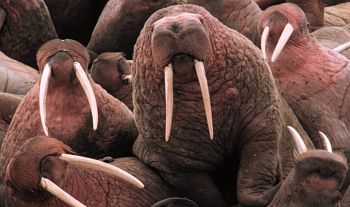
La página que intenta visitar sólo está disponible en inglés. ¡Disculpa!
The page you are about to visit is currently only available in English. Sorry!

 |
| Photo Courtesy of US Fish and Wildlife Service |
Thanks to the influx of greenhouse gases spewed into the atmosphere in recent history, the Arctic has been undergoing major ecological changes - record high sea ice melting, declines in terrestrial snow cover, and temperature increases two to three times the global average. But while scientists have been scrambling to understand how climate change will affect the Arctic’s systems, a study published in this week’s Science argues not enough attention has been given to the impacts these changes are having on the region's flora and fauna.
"Species on land and at sea are suffering adverse consequences of human behavior at latitudes thousands of miles away," Post said in a statement. "It seems no matter where you look -- on the ground, in the air, or in the water -- we're seeing signs of rapid change."
Using information collected during the Fourth International Polar Year – a collaborative period in which scientists from across the globe focus their research on the Earth’s polar regions – the study found that changes to sea ice, temperature, and nutrient cycles are drastically altering relationships between terrestrial and marine life and endangering several species, including the ivory gull, ringed seal, hooded seal, narwhal, polar bear, and Pacific walrus. Changing temperatures also mean shifting biomes, which is influencing fish migrations and causing Arctic fox numbers to decline as red foxes move into their territory. Changes to the Arctic’s seasonal timing mean caribou calves are now born when food availability is low and adults have to deal with higher numbers of insects and parasites due to the lengthening of summer-like weather and temperatures.
The research team, led by Eric Post from the Penn State University and the Department of Arctic Environment at Aarhus University in Denmark, believes the changing ecosystems in the Arctic are a bellwether of how climate change will affect lower latitudes. They are calling for additional research into how species interactions and survival are changing in response to changing environment and also argue the region desperately needs more conservation projects.
The study comes on the heel of the Fish and Wildlife Service’s announcement that they are looking into protecting the Pacific walrus, one of the species named at risk by the research team, under the Endangered Species Act. According to FWS, the decision was influenced by the impact climate change, particularly ice melt, has on the walrus’ ability to find food and protect itself. But the Science paper’s cry for increased conservation efforts for Arctic species and FWS’s review of the walrus will hit a major snag when they try to go against a piece of Bush legislation that has outraged environmentalists since it was enacted. After placing the polar bear on the endangered species list in March 2008, the Bush administration wrote a rule stating greenhouse gases were no longer allowed to be named as a potential threat to any species in review for the endangered species list. And as of now, it doesn’t look like the rule will overturned anytime soon.